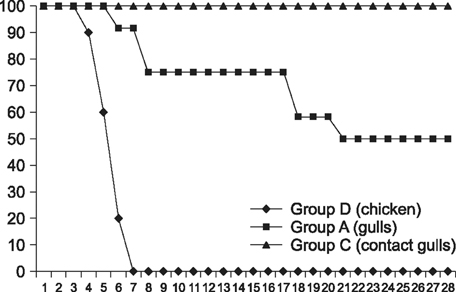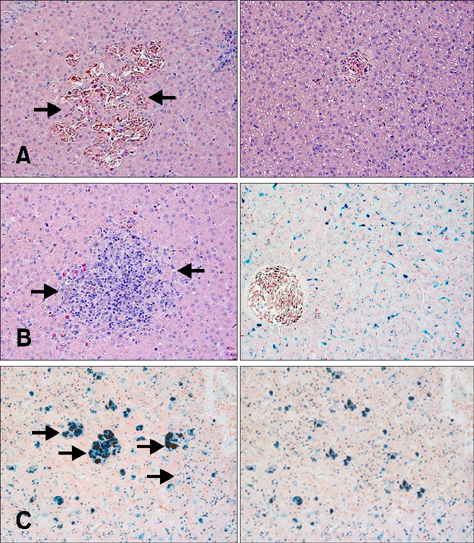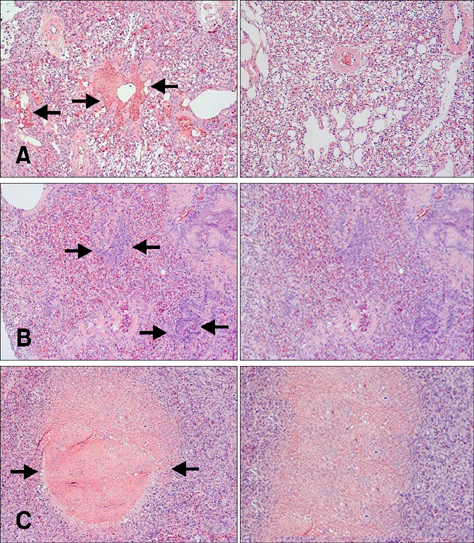J Vet Sci.
2016 Jun;17(2):179-188. 10.4142/jvs.2016.17.2.179.
Experimental infection and pathology of clade 2.2 H5N1 virus in gulls
- Affiliations
-
- 1Faculty of Natural Sciences, Novosibirsk State University, Novosibirsk 630090, Russia. sharshov@yandex.ru
- 2State Research Center of Virology and Biotechnology "Vector", Novosibirsk 630559, Russia.
- 3Institute of Experimental and Clinical Medicine, Russian Academy of Sciences, Novosibirsk 630117, Russia.
- KMID: 2413167
- DOI: http://doi.org/10.4142/jvs.2016.17.2.179
Abstract
- During 2006, H5N1 HPAI caused an epizootic in wild birds, resulting in a die-off of Laridae in the Novosibirsk region at Chany Lake. In the present study, we infected common gulls (Larus canus) with a high dose of the H5N1 HPAI virus isolated from a common gull to determine if severe disease could be induced over the 28 day experimental period. Moderate clinical signs including diarrhea, conjunctivitis, respiratory distress and neurological signs were observed in virus-inoculated birds, and 50% died. The most common microscopic lesions observed were necrosis of the pancreas, mild encephalitis, mild myocarditis, liver parenchymal hemorrhages, lymphocytic hepatitis, parabronchi lumen hemorrhages and interstitial pneumonia. High viral titers were shed from the oropharyngeal route and virus was still detected in one bird at 25 days after infection. In the cloaca, the virus was detected sporadically in lower titers. The virus was transmitted to direct contact gulls. Thus, infected gulls can pose a significant risk of H5N1 HPAIV transmission to other wild migratory waterfowl and pose a risk to more susceptible poultry species. These findings have important implications regarding the mode of transmission and potential risks of H5N1 HPAI spread by gulls.
Keyword
MeSH Terms
Figure
Reference
-
1. Abdullazyanova ER, Zajkovsmaya AV, Shestopalova LV, Shestopalov AM. Study of pathogenetic features infectious caused by highly pathogenic influenza virus A/H5N1 in wild ducks and domestic chickens. Bulletin ESSC SB RAMS. 2012; 5:163–165.2. Alexander DJ. An overview of the epidemiology of avian influenza. Vaccine. 2007; 25:5637–5644.
Article3. Bahl AK, Pomeroy BS. Experimental exposure of Franklins' gulls (Larvus pipixcan) and mallards (Anas platyrhynchos) to a turkey influenza A virus A/Turkey/Minn/BF/72 (Hav6Neq2). J Wildl Dis. 1977; 13:420–426.
Article4. Brown JD, Stallknecht DE, Beck JR, Suarez DL, Swayne DE. Susceptibility of North American ducks and gulls to H5N1 highly pathogenic avian influenza viruses. Emerg Infect Dis. 2006; 12:1663–1670.
Article5. Brown JD, Stallknecht DE, Swayne DE. Experimental infections of herring gulls (Larus argentatus) with H5N1 highly pathogenic avian influenza viruses by intranasal inoculation of virus and ingestion of virus-infected chicken meat. Avian Pathol. 2008; 37:393–397.
Article6. Costa TP, Brown JD, Howerth EW, Stallknecht DE. Variation in viral shedding patterns between different wild bird species infected experimentally with low-pathogenicity avian influenza viruses that originated from wild birds. Avian Pathol. 2011; 40:119–124.
Article7. Ellis TM, Bousfield RB, Bissett LA, Dyrting KC, Luk GSM, Tsim ST, Sturm-Ramirez K, Webster RG, Guan Y, Malik Peiris JS. Investigation of outbreaks of highly pathogenic H5N1 avian influenza in waterfowl and wild birds in Hong Kong in late 2002. Avian Pathol. 2004; 33:492–505.
Article8. Fouchier RAM, Munster V, Wallensten A, Bestebroer TM, Herfst S, Smith D, Rimmelzwaan GF, Olsen B, Osterhaus ADME. Characterization of a novel influenza A virus hemagglutinin subtype (H16) obtained from black-headed gulls. J Virol. 2005; 79:2814–2822.
Article9. Gibbs SE. Avian biology, the human influence on global avian influenza transmission, and performing surveillance in wild birds. Anim Health Res Rev. 2010; 11:35–41.
Article10. Hall JS, Franson JC, Gill RE, Meteyer CU, TeSlaa JL, Nashold S, Dusek RJ, Ip HS. Experimental challenge and pathology of highly pathogenic avian influenza virus H5N1 in dunlin (Calidris alpina), an intercontinental migrant shorebird species. Influenza Other Respir Viruses. 2011; 5:365–372.
Article11. Hall JS, Krauss S, Franson JC, TeSlaa JL, Nashold SW, Stallknecht DE, Webby RJ, Webster RG. Avian influenza in shorebirds: experimental infection of ruddy turnstones (Arenaria interpres) with avian influenza virus. Influenza Other Respir Viruses. 2013; 7:85–92.
Article12. Hanson BA, Luttrell MP, Goekjian VH, Niles L, Swayne DE, Senne DA, Stallknecht DE. Is the occurrence of avian influenza virus in Charadriiformes species and location dependent? J Wildl Dis. 2008; 44:351–361.
Article13. Höfle U, Van de Bildt MWG, Leijten LM, Van Amerongen G, Verhagen JH, Fouchier RAM, Osterhaus ADME, Kuiken T. Tissue tropism and pathology of natural influenza virus infection in black-headed gulls (Chroicocephalus ridibundus). Avian Pathol. 2012; 41:547–553.
Article14. Jeong OM, Kim MC, Kim MJ, Kang HM, Kim HR, Kim YJ, Joh SJ, Kwon JH, Lee YJ. Experimental infection of chickens, ducks and quails with the highly pathogenic H5N1 avian influenza virus. J Vet Sci. 2009; 10:53–60.
Article15. Kawaoka Y, Krauss S, Webster RG. Avian-to-human transmission of the PB1 gene of influenza A viruses in the 1957 and 1968 pandemics. J Virol. 1989; 63:4603–4608.
Article16. Li KS, Guan Y, Wang J, Smith GJD, Xu KM, Duan L, Rahardjo AP, Puthavathana P, Buranathai C, Nguyen TD, Estoepangestie ATS, Chaisingh A, Auewarakul P, Long HT, Hanh NTH, Webby RJ, Poon LLM, Chen H, Shortridge KF, Yuen KY, Webster RG, Peiris JSM. Genesis of a highly pathogenic and potentially pandemic H5N1 influenza virus in eastern Asia. Nature. 2004; 430:209–213.
Article17. Lipatov AS, Krauss S, Guan Y, Peiris M, Rehg JE, Perez DR, Webster RG. Neurovirulence in mice of H5N1 influenza virus genotypes isolated from Hong Kong poultry in 2001. J Virol. 2003; 77:3816–3823.
Article18. Makarova NV, Kaverin NV, Krauss S, Senne D, Webster RG. Transmission of Eurasian avian H2 influenza virus to shorebirds in North America. J Gen Virol. 1999; 80:3167–3171.
Article19. Marchenko VIu, Sharshov KA, Silko N, Susloparov IM, Durymanov AG, Zaĭkovskala AV, Alekseev A, Smolovskaia OV, Stefanenko AP, Malkova EM, Shestopalov AM. Characterization of the H5N1 influenza virus isolated during an outbreak among wild birds in Russia (Tuva Republic) in 2010. Mol Gen Mikrobiol Virusol. 2011; 36–40.
Article20. Marchenko VY, Alekseev AY, Sharshov KA, Petrov VN, Silko NY, Susloparov IM, Tserennorov D, Otgonbaatar D, Savchenko IA, Shestopalov AM. Ecology of influenza virus in wild bird populations in Central Asia. Avian Dis. 2012; 56:234–237.
Article21. Mundt E, Gay L, Jones L, Saavedra G, Tompkins SM, Tripp RA. Replication and pathogenesis associated with H5N1, H5N2, and H5N3 low-pathogenic avian influenza virus infection in chickens and ducks. Arch Virol. 2009; 154:1241–1248.
Article22. Normile D. Avian influenza. Potentially more lethal variant hits migratory birds in China. Science. 2005; 309:231.
Article23. Olsen B, Munster VJ, Wallensten A, Waldenström J, Osterhaus AD, Fouchier RA. Global patterns of influenza A virus in wild birds. Science. 2006; 312:384–388.
Article24. Perkins LE, Swayne DE. Susceptibility of laughing gulls (Larus atricilla) to H5N1 and H5N3 highly pathogenic avian influenza viruses. Avian Dis. 2002; 46:877–885.
Article25. Sayfutdinova SG, Sharshov KA, Gerasimov YN, Shestopalov AM. Ecology of influenza A viruses, isolated from gulls of the Russian Far East. Bulletin ESSC SB RAMS. 2012; 5:316–318.26. Sharshov K, Silko N, Sousloparov I, Zaykovskaya A, Shestopalov A, Drozdov I. Avian influenza (H5N1) outbreak among wild birds, Russia, 2009. Emerg Infect Dis. 2010; 2:349–351.
Article27. Sharshov KA, Kurskaia OG, Zaĭkovskaia AV, Iurlov AK, Susloparov IM, Ternovoĭ VA, Durymanov AG, Zolotykh SI, Shestopalov AM, Drozdov IG. Characteristic of high pathogenic avian influenza virus subtype H5N1 isolated from common gull (Larus canus). Zh Mikrobiol Epidemiol Immunobiol. 2010; 29–32.28. Shestopalova LV, Shkurupiy VA, Sharkova TV, Shestopalov AM. Morphological changes in bird viscera in experimental infection by highly pathogenic H5N1 avian influenza virus. Bull Exp Biol Med. 2008; 146:770–773.
Article29. Sivay MV, Baranovich T, Marchenko VY, Sharshov KA, Govorkova EA, Shestopalov AM, Webby RJ. Influenza A (H15N4) virus isolation in Western Siberia, Russia. J Virol. 2013; 87:3578–3582.
Article30. Sivay MV, Sayfutdinova SG, Sharshov KA, Alekseev AY, Yurlov AK, Runstadler J, Shestopalov AM. Surveillance of influenza A virus in wild birds in the Asian portion of Russia in 2008. Avian Dis. 2012; 56:456–463.
Article31. Suzuki K, Okada H, Itoh T, Tada T, Mase M, Nakamura K, Kubo M, Tsukamoto K. Association of increased pathogenicity of Asian H5N1 highly pathogenic avian influenza viruses in chickens with highly efficient viral replication accompanied by early destruction of innate immune responses. J Virol. 2009; 83:7475–7486.
Article32. Swayne DE, Glisson JR, Jackwood MW, Pearson JE, Reed WM. A Laboratory Manual for the Isolation and Identification of Avian Pathogens. 4th ed. Chester County: American Association of Avian Pathologists;2006. p. 74–80. p. 150–163. p. 235–240.33. Teifke JP, Klopfleisch R, Globig A, Starick E, Hoffmann B, Wolf PU, Beer M, Mettenleiter TC, Harder TC. Pathology of natural infections by H5N1 highly pathogenic avian influenza virus in mute (Cygnus olor) and whooper (Cygnus cygnus) swans. Vet Pathol. 2007; 44:137–143.
Article34. Van Borm S, Rosseel T, Vangeluwe D, Vandenbussche F, van den Berg T, Lambrecht B. Phylogeographic analysis of avian influenza viruses isolated from Charadriiformes in Belgium confirms intercontinental reassortment in gulls. Arch Virol. 2012; 157:1509–1522.
Article35. Velarde R, Calvin SE, Ojkic D, Barker IK, Nagy E. Avian influenza virus H13 circulating in ring-billed gulls (Larus delawarensis) in southern Ontario, Canada. Avian Dis. 2010; 54:1 Suppl. 411–419.
Article36. Webby RJ, Webster RG. Are we ready for pandemic influenza? Science. 2003; 302:1519–1522.
Article37. Webster RG, Bean WJ, Gorman OT, Chambers TM, Kawaoka Y. Evolution and ecology of influenza A viruses. Microbiol Rev. 1992; 56:152–179.
Article38. World Health Organization. Cumulative number of confirmed human cases of avian influenza A (H5N1) reported to WHO, 2003-2013. Geneva: World Health Organization;2013.39. World Health Organization. WHO global influenza surveillance network: manual for the laboratory diagnosis and virological surveillance of influenza. Geneva: World Health Organization;2011. p. 79–82.40. Zaĭkovskaia AV, Sharshov KA, Sherstkov EA, Iurlov AK, Shestopalov AM. Experimental infection caused by influenza A (H5N1) virus in common gull (Larus canus). Vopr Virusol. 2012; 57:43–46.
- Full Text Links
- Actions
-
Cited
- CITED
-
- Close
- Share
- Similar articles
-
- Evolutionary dynamics of highly pathogenic avian influenza A/H5N1 HA clades and vaccine implementation in Vietnam
- Surveillance of wild birds for avian influenza virus in Korea
- Improving siRNA design targeting nucleoprotein gene as antiviral against the Indonesian H5N1 virus
- Genetic diversity of the H5N1 viruses in live bird markets, Indonesia
- Control of Avian Influenza: Calls for International Collaboration






